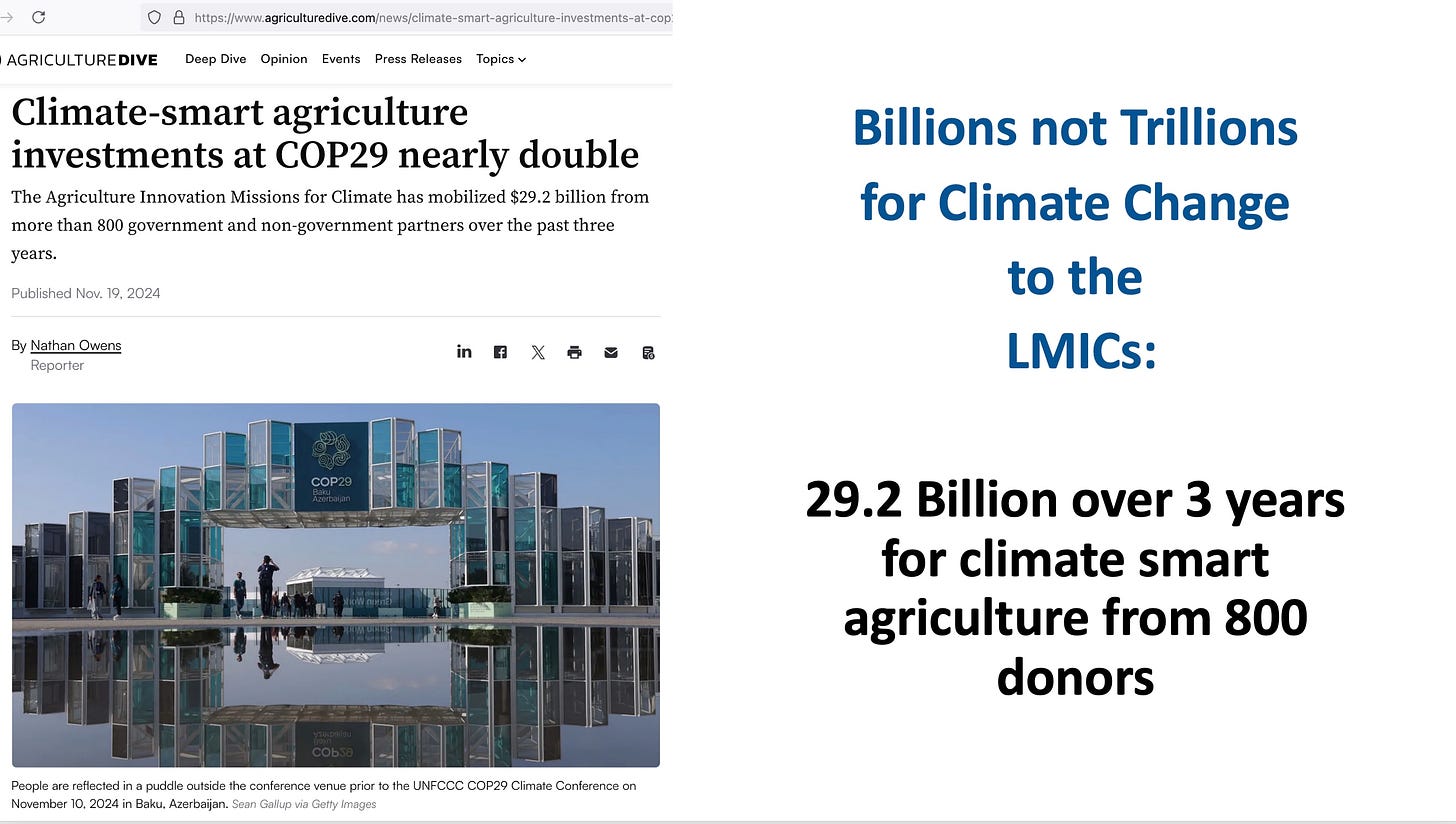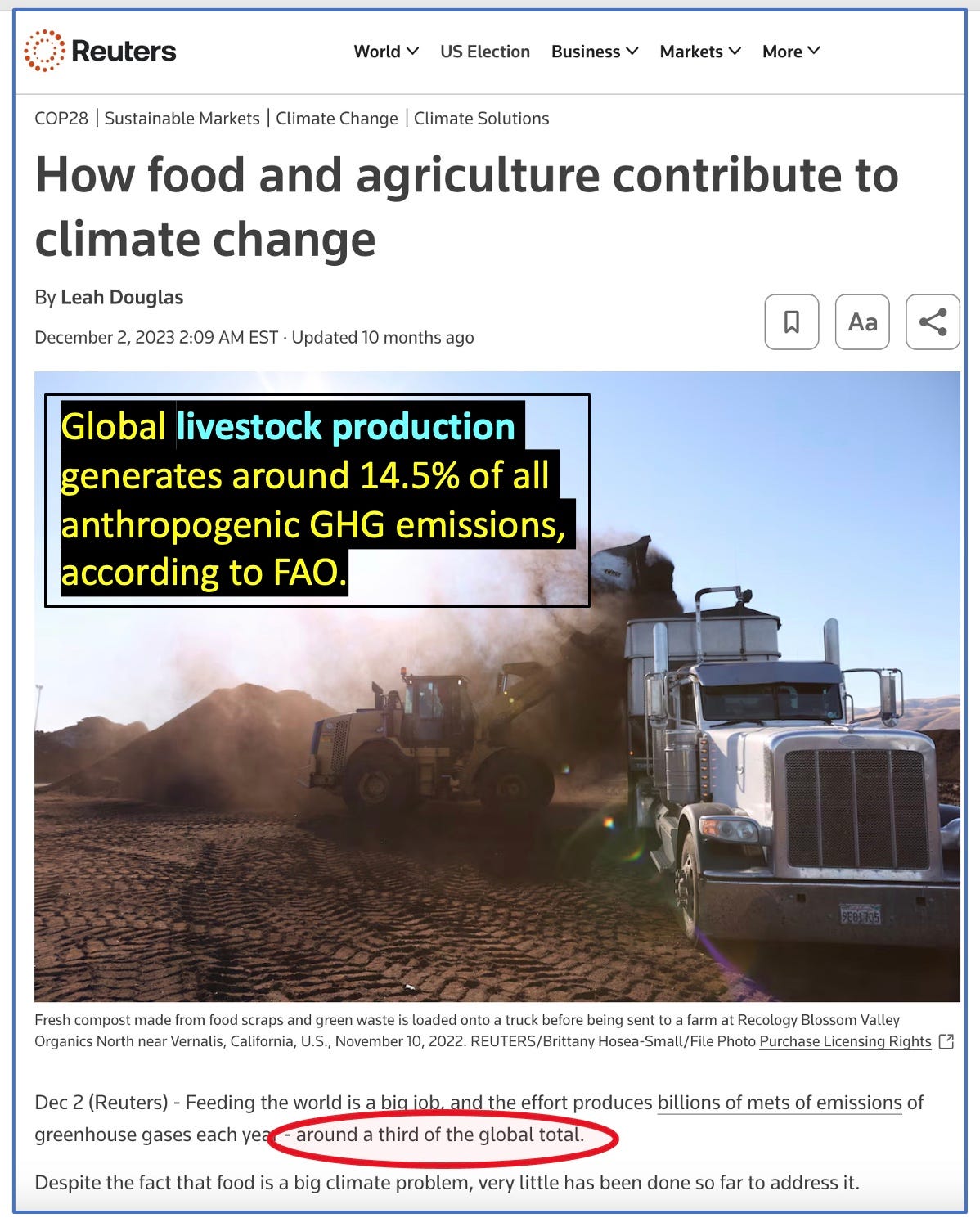COP29 Extravaganza seems to be ending on sour note: the expected promise of $1 trillion plus/year to poor countries evaporated
UN's Climate Conference did come up with $30 billion promised for climate agriculture, but are bug factories really the answer?
The COP29 meeting was to have ended at 6 pm in Baku, Azerbaijan today, but the nations could not come to an agreement on how much money would be promised to the low and middle income countries (LMIC), so the meeting is continuing into the night. It is already after 1 am on the 23d in Baku.
LMIC demands seem to have ranged from 1 to 5 Trillion dollars per year, with many settling on $1.3 Trillion per year as the “right” number. Today the richer nations proposed giving $250 billion (in some combo of loans and grants) by 2035. Who knows what $250 billion will be worth then, at the rate inflation has been going? So far, no deal.
The thing is, no one knows how much it would cost to prepare for and mitigate climate-associated damage. Nor do they know what the money would be spent on. That makes it difficult to come up with an amount. Though that does not seem to have stopped the negotiators.
According to Aljazeera,
There was also no guarantee that the money, which is expected to be raised by both governments and the private sector, would flow through grants. That could mean more loans that accrue debt for developing countries.
Here is an interesting take from the Guardian:
The $100 billion figure was "plucked out of the air," said Rachel Kyte, the UK's new climate envoy, speaking before her appointment to the role. The offer was made – largely at the instigation of the then US Secretary of State, Hillary Clinton – based on political calculations of what developed country governments thought their electorates would stand for.
A little money was promised for the effects of climate change on agriculture, amounting to about $10 billion dollars per year.
Even though the international “experts” claim that agriculture contributes to 33% of global warming emissions, with livestock alone contributing nearly half of that, agriculture only got a pittance. But if agriculture causes a third of global warming, shouldn’t it receive a third of the promised climate funding? $10 Billion/yr is less than 1% of $1.3 trillion, and is 4% of $250 billion/yr.
Where do you think that $30 billion is going? Some of it is going to a massive expansion of insect farms, mostly growing mealworms and crickets.
Yes, every yellow or green circle in the 2023 article above represents an edible insect producer. But because the powers that be have not yet convinced us to eat ze bugs, most of their production today goes into food for animals. But there is still plenty for humans. Here are some of the products:
Our generous governments have been throwing money at these companies over the past several years. But maybe the bug food producers and their investors are starting to see the light, realizing that the world is taking a new tack. (H/T to Dr. William Makis for this article:)
https://nationalpost.com/opinion/trudeau-9-million-bet-on-edible-crickets-runs-into-trouble
Just two years after the Trudeau government put up nearly $9 million to help build the world’s largest edible cricket factory, the facility is dramatically cutting staff and production in what they say is an extended retooling.
Aspire Food Group, which cut the ribbon last year on a 150,000-square-foot edible cricket factory in London, Ont., has just laid off two thirds of its workforce and significantly cut back shifts, saying they need to make “some improvements to its manufacturing system.”
Speaking to the trade publication AgFunderNews, Aspire CEO David Rosenberg said the company “will be running the production line four times a week instead of two shifts a day every day. We’re 150 people down to 50 and we plan on hiring back up in July.”
This is despite very generous grants from the Trudeau government. In June 2022, Agriculture and Agri-Food Canada announced a grant of “up to $8.5 million” to build a “commercial facility to produce cricket protein.”
What resulted was a factory billed by Aspire as the “world’s largest cricket production facility.” As per a CBC profile published at its grand opening, the factory was to house four billion crickets at any one time, and churn out 13 million kilograms of edible crickets each year.
Aspire’s signature pitch – and one of the main reasons they attracted federal government attention – is that crickets have a lower environmental footprint than meat or dairy.
The 2022 Government of Canada statement announcing the $8.5 million grant mentioned this several times. The subsidy would help Aspire produce “high volumes of nutritious food with a low environmental footprint” and “meet global demand for food by using less water, energy and space and emitting significantly less greenhouse gas emissions.”
“Aspire will be at home here as the company re-defines what is possible in the insect protein sector, creating new solutions for sustainable food production,” Liberal MP Arielle Kayabaga said in the statement.
In September 2022, Aspire announced an agreement with the Korean food distributor Lotte Confectionary Co. Ltd. – pitching it as their first deal to sell cricket powder for human consumption. However, the deal was only a memorandum of understanding to “formalize their cooperation in the distribution and promotion of crickets as food.”
According to the AgFunderNews story announcing mass layoffs and production slowdowns, the facility was still mainly selling its crickets to pet food manufacturers as of March 2023.
AgFunderNews also noted that – just a year prior – Aspire had been saying that they would be at 100 per cent capacity by early 2024, and likely had enough orders to handle all the production. “We have significant contractual commitments for the majority of our production and expect 100% will be sold within the year,” then-CEO Mohammed Ashour had told AgFunderNews in March 2023.
Founded by five McGill University students, Aspire grew out of a proposal that in 2013 won the $1 million Hult Prize, an award for student entrepreneurship run by the Clinton Global Initiative.
The team, led by Ontario man Ashour, had pitched Hult on a plan to solve world hunger through factories producing cheap protein made from insects. The initial idea was to have miniature cricket farms contained within shipping containers that could be moved into developing countries to produce protein-rich flour.
Trump’s election may be saving us from eating ze bugs, as well as nuclear war. (It is said the chief of NATO, the Netherland’s (and Globalists’) Mark Rutte, is meeting with Trump at Mar a Lago right now). This is when we need someone who knows how to make a deal.











IMHO we need more regenerative meat farms starting not bug factories.
At 90 I am in better health than most people half my age. Every day I fast walk for an hour covering several miles at least. For over fifty years,, I lived on fruits and veggies...and the only problem was the excess fat in what I put on my salads. Today, I eat as much fruit as possible and have eliminated salads. I rarely ate animal protein from 1973 - 2023., but my daughter wanted to raise chickens.
She feeds them very carefully and even gives them organic produce; so now I'm eating eggs .. I have no physical problems. Excess protein is a killer! The standards for protein, fat, carbs, sodium, etc. were set by the food industry to sell more products. Before the protein promotion started, people were not obese like they are today.